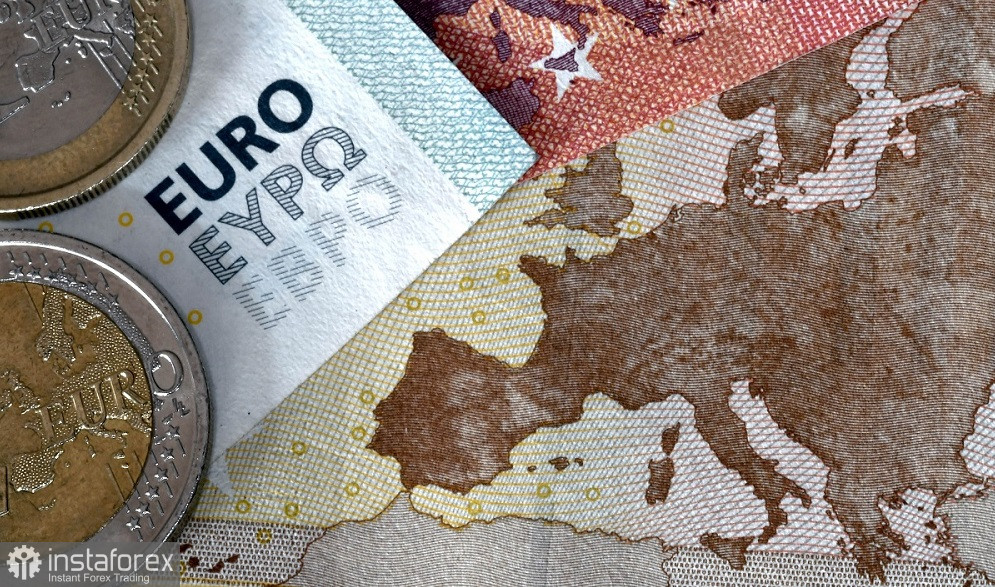During the European trading session, the EUR/USD pair tried to develop corrective growth amid mixed data on Germany's and the Eurozone's GDP. However, the price turned down again at the start of the U.S. session. Traders are clearly nervous ahead of the Federal Reserve's July meeting, the results of which will be announced on Wednesday, July 31. While it cannot be said that market participants completely ignored the European reports, traders are currently anticipating the Fed's verdict.
There is no doubt that the latest reports will resurface in the future when the discussion about the prospects of the European Central Bank's rate cuts in September and subsequent meetings resumes. But at the moment, these reports are useless for EUR/USD, partly due to their contradictory nature.

Germany's GDP unexpectedly decreased by 0.1% quarter-on-quarter in the second quarter, while most experts expected a 0.1% increase. The German economy grew by 0.2% in the first quarter, while it contracted by 0.5% in the fourth quarter of 2023. On an annual basis, GDP volume increased by 0.3% (in line with the forecast) after a decline of 0.8% in the previous quarter.
In other words, Europe's largest economy showed weak results. However, the Eurozone GDP report was on the other side of the scale. Here, the main components met the forecast or were in the "green." The European economy grew by 0.3% quarter-on-quarter in the second quarter, as in the first quarter. The forecast was at 0.2%. On an annual basis, GDP volume increased by 0.6% (marking the third consecutive quarter of growth).
The Consumer Price Index for Germany was also published on Tuesday. The report supported the euro, especially since it was released ahead of the Eurozone inflation report. The German CPI rose by 0.3% month-on-month in July (in line with the forecast) and 2.3% year-on-year (against a forecast of 2.2%). The harmonized index, the preferred inflation indicator of the European Central Bank, increased by 2.6% year-on-year, while most experts had predicted a more modest growth of 2.4% (June saw a 2.5% increase).
What do we have in summary? Fact #1: The Eurozone economy is growing despite the downturn in the German economy. Fact #2: Inflation in Germany has slightly accelerated, indicating a "green tint" in the inflation report for the entire Eurozone (this report will be released on Wednesday, July 31).
In my opinion, these facts reduce the likelihood of the ECB easing monetary policy in September, especially if the Eurozone inflation rate does accelerate. The suspense surrounding the outcome of the September meeting has intensified — a September rate cut no longer seems like a foregone conclusion.
It is important to recall that the results of the ECB's July meeting were unfavorable for the single currency precisely because the central bank indicated it was still uncertain about a rate cut in September. One phrase from ECB President Christine Lagarde ("Any decision can be made in September") speaks volumes. In answer to this question, the ECB head noted that the issue of a rate cut in September remains open, but the decision will depend on incoming data. Commenting on the Eurozone's CPI report for June (which reflected a slight slowdown in the overall CPI and stagnation in the core index), she stated that the services sector, where inflation is 4.1%, has increased upward risks.
If the Eurozone inflation report for July disappoints the ECB again, the prospects for easing monetary policy in September will be in serious doubt. According to preliminary forecasts, the CPI is expected to slow down in July: the overall CPI (down to 2.4% from the previous 2.5%) and the core index (down to 2.8% from the previous 2.9%) are projected to show a downward trend. However, the puzzle will come together if inflation indicators accelerate (contrary to forecasts). The market will again discuss the ECB not lowering rates in early autumn. In that case, the euro could receive substantial support.
However, regardless of its outcome, do not expect the EUR/USD pair to react immediately to the Eurozone inflation report. Until the Fed's verdict is announced, dollar pairs will be focused solely on the behavior of the US currency, and the EUR/USD pair will be no exception.
However, once the excitement over the Fed's July meeting results subsides, traders will recall the European data. If the Fed does not favor the greenback, the rise in inflation in Germany and (possibly) in the Eurozone could play an important, decisive role in determining the pair's upward trend. However, it's still too early to talk about this. All attention is on the Fed, which will determine the dollar's fate in the medium term.





















